December 23, 2010, 16:47:00 GMT
permalink Post: 6139777
Wasn't me, honest, guv. 'T was that other dude...
Any chance of a pic or a drawing, M2dude?
It seems almost impossible to me that it was 'something' between inner and outer wing, since it would have had to 'jump' over the bathtub covers.
IMO everything went through rib 12, not under or over it.
CJ
Subjects: None
No recorded likes for this post (could be before pprune supported 'likes').Reply to this quoting this original post. You need to be logged in. Not available on closed threads.
December 23, 2010, 18:36:00 GMT
permalink Post: 6139975
OK all.
On the 'blunties' and most other aircraft (subsonic or supersonic) there is a fuselage, and there is a wing.
The wing is connected to the fuselage by only a few very big bolts, linking a few very big forgings.
Concorde is different, right? Right.
Fuselage and inner wing are the same structure, and there were no "big bolts" that allowed you to separate fuselage and inner wing once the aircraft was built.
The only separate "bits" were the outer wings, the parts just outside the engine nacelles.
So 'rib 12' was the rib where the inner wing ended, and where the outer wing (built by Dassault, rather than Aerospatiale, actually) was attached.
Rib 12 actually was two halves, the one at the outboard side of the inner wing, and the one on the inboard side of the outer wing.
Both machined numerically from single 'blanks'...
And no, these two halves were NOT just bolted together with a few massive bolts. They were bolted together with hundreds of bolts in all. I did say Concorde was different, no?
Words now fail me, and I'll have to find or scribble some drawings ASAP.
In brief, so far.. each half of rib 12 had MANY machined "bath tub shaped" slots allowing to insert a bolt between the two halves, and bolt the outer wings to the inner wings.
And simplistically, the 'bath tub covers' were just small sheet panels held in place with fasteners fitted inside the 'bath tub' slots.
I should know.... I still have the scars of helping, one day, to refit a batch of them on Delta Golf at Brooklands
CJ
Subjects
Aerospatiale
Brooklands
G-BBDG
Links are to this post in the relevant subject page so that this post can be seen in context.
Reply to this quoting this original post. You need to be logged in. Not available on closed threads.
December 23, 2010, 22:21:00 GMT
permalink Post: 6140342
Thanks for the picture, saves me a thousand scribbles.
And it also shows my mistaek... rib 12 was only inboard.
The outer wing did not have a "rib 12", it was the upper and lower edges of the skin that had their own "bath tubs".
CJ
Subjects: None
No recorded likes for this post (could be before pprune supported 'likes').Reply to this quoting this original post. You need to be logged in. Not available on closed threads.
December 24, 2010, 16:39:00 GMT
permalink Post: 6141629
M2dude will have to confirm that the 'lateral stiffeners' he is thinking of are indeed the very roughly 2' long and 5" strips at the location of each spar just outboard of the engine, that are very clearly visible on Coffin Dodger's photo of 'AA.
If so, they are indeed shown in the structural repair manual and listed as 'doublers'. There are ten of those, from spar 62 to spar 71.
Reading "between the lines", the modification dates from about 1978, and was applied by successive service bulletins to both the BA and AF aircraft.
CJ
Subjects
Air France
British Airways
Links are to this post in the relevant subject page so that this post can be seen in context.
Reply to this quoting this original post. You need to be logged in. Not available on closed threads.
December 24, 2010, 17:09:00 GMT
permalink Post: 6141672
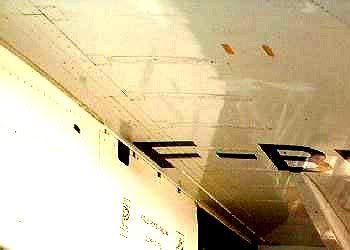
and as you see, they show up quite clearly on Fox Bravo as well.
Judging by the page dates in the SRM, BA started it all, and Air France followed, with all the aircraft being modified by 1981. But that's just my guess.
CJ
Subjects
Air France
British Airways
Links are to this post in the relevant subject page so that this post can be seen in context.
Reply to this quoting this original post. You need to be logged in. Not available on closed threads.
December 24, 2010, 17:25:00 GMT
permalink Post: 6141703
You're looking at a generic picture of the junction between the upper and lower skins of the innner and outer wings at the level of rib 12, which is the rib just outboard of the engines.
The 'sample' you're looking at in that diagram has been "cut away" between two spars. The strengtheners are on the spars themselves, so they don't show up here.
CJ
Subjects: None
No recorded likes for this post (could be before pprune supported 'likes').Reply to this quoting this original post. You need to be logged in. Not available on closed threads.
December 24, 2010, 21:35:00 GMT
permalink Post: 6142030
In my case, it's easier... I've become bitten by the Concorde bug again over the last ten years or so, and pulled dozens of similar diagrams from the documentation to refresh my memory.
Op-amps also were used for other functions such as demodulators (converting AC signals to DC) or comparators and level detectors.
I still mean to write some posts on "how to compute without a digital computer", but it'll have to wait until after the holidays.

In the 'olden' days we'd draw block diagrams like the one for the SFC, and once we agreed about all the functions we wanted, we just drew the schematics for each of the functions.
No sequencing, no real-time clock, no A/D or D/A conversion, no worries about cycle time or memory allocation. No programming-language issues, no naming of variables, no compiler faults, no software to debug.
You should try it sometime......
The major issue was, of course, that you ended up with a lot more hardware for the same functionalities, hence more weight, and more power consumption.
And the other issue, already alluded to in earlier posts, is that analogue computing is inherently not highly accurate.
In many cases of system control, a percent or two of precision is perfectly acceptable. But if a far higher precision is needed, like for instance in the intertial navigation system, or the core computing for the air intakes, only digital computing can do the job.
Seasons greetings to everyone on this thread from me too.
Christian
Subjects
Intakes
Links are to this post in the relevant subject page so that this post can be seen in context.
Reply to this quoting this original post. You need to be logged in. Not available on closed threads.
December 25, 2010, 22:37:00 GMT
permalink Post: 6143159
Flight envelope
Those are the official certified limits.
I doubt somehow anybody went beyond those "for the press".....
But during certification, yes, each of those limits was exceeded, slowly and carefully, to be able to draw those official operational limits on the document.
For instance, the certified Mmo is 2.04. During certification, G-BBDG (202) went to Mach 2.21....
Even while staying within the limits, she could could exceed Mach 1 just below 30,000 ft.
Also, during the acceptance flights after major overhauls, most of those envelope limits would be exceeded by a given margin, to prove the aircraft still met all the certification requirements. Whether any of that was done 'closer to the deck', I wouldn't know.
The 'issues' would vary. Performance would be one issue... Delta Golf (and 01, who went to Mach 2.23) basically "ran out of steam" at that speed.
Another issue would be that 'going beyond the borders' shortened the fatigue life of the airframe, and it was difficult to assess exactly by how much. It was one of the reasons why Delta Golf and Sierra Bravo (the certification aircraft) in the end never went into service.
CJ
Subjects
FL600
Fatigue
Flight Envelope
G-BBDG
Mmo
Links are to this post in the relevant subject page so that this post can be seen in context.
Reply to this quoting this original post. You need to be logged in. Not available on closed threads.
December 26, 2010, 14:44:00 GMT
permalink Post: 6143885
Maybe the original poster remembers and can point us back?
CJ
Subjects: None
No recorded likes for this post (could be before pprune supported 'likes').Reply to this quoting this original post. You need to be logged in. Not available on closed threads.
December 26, 2010, 15:58:00 GMT
permalink Post: 6143964
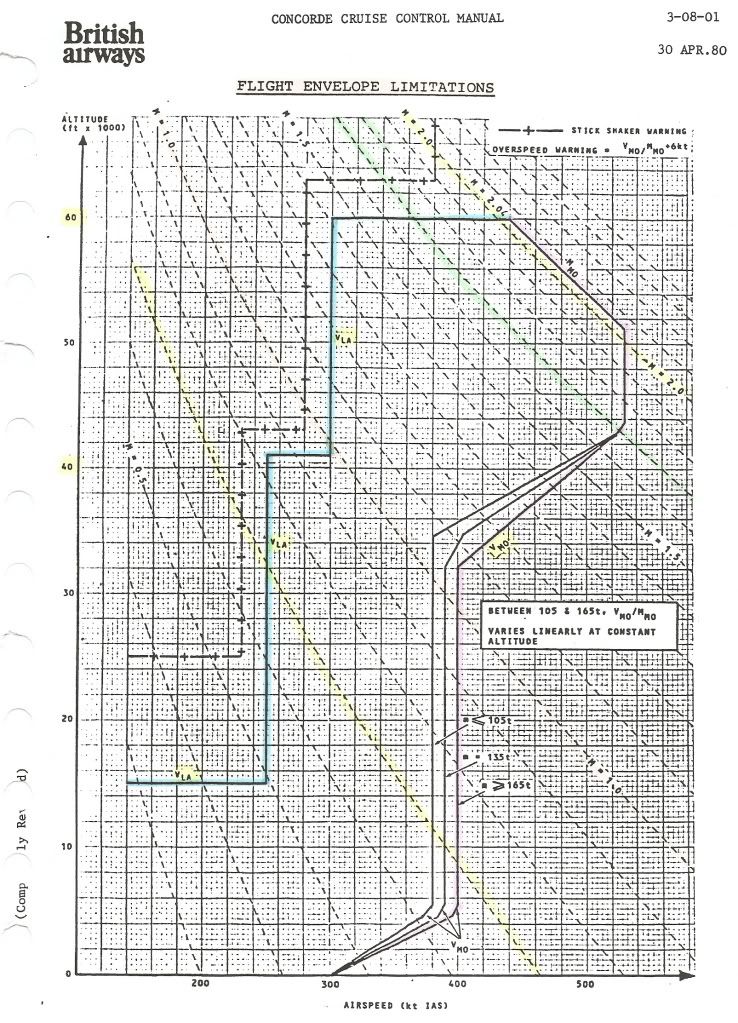
Mike's earlier question had me scratching my head too, hence my question.
What are the fundamental reasons for each of the limitations, and what were the consequences of going outside them?
Going clockwise from the left, we have :
VLA (lowest admissible speed)
One would expect a curve for constant alpha max against IAS and altitude, not the staircase in the diagram.
Was this for simplicity of use of the diagram?
Max altitude (60,000ft)
This is the 'simplest' one: it was the highest 'safe' altitude from which an emergency descent could be made, in the case of a window blowing out, without having the blood of the pax boil....
Test flights (without pax, and with the crew pressure-breathing oxygen) did go as high as 69,000ft.
Mmo (max operating Mach number)
Mach 2.04 is usually quoted as having been chosen to assure an adequate life of the airframe.
But what effect does a higher Mach number as such have?
Or are Mmo and Tmo (127\xb0C) directly related?
Vmo (max operating speed) = 530kts until 43,000ft
I suppose this is related to structural limits (qmax)?
Vmo reducing to 380/400kts at about 33,000ft
What is the limiting factor here (other than qmax)?
Vmo constant at 380/400kts down to 5,000ft
What is the limiting factor here? The answer will no doubt also explain why this is slightly weight-dependent.
Vmo reducing to 300kts between 5,000ft and 0 ft
Why the sudden change below 5,000ft?
CJ
Subjects
Depressurisation
Flight Envelope
IAS (Indicated Air Speed)
Mmo
TMO (Temprature Max Operating)
Vmo
Links are to this post in the relevant subject page so that this post can be seen in context.
Reply to this quoting this original post. You need to be logged in. Not available on closed threads.
December 26, 2010, 17:30:00 GMT
permalink Post: 6144082
LOL.....
If so, same question.
Can you explain the boundaries of the Olympus Relight Envelope?

Cheers,
CJ
PS : If you have a graph for that, it would be most gratefully received here, I'm sure!
Last edited by ChristiaanJ; 26th December 2010 at 18:07 . Reason: Added 'PS'
Subjects
Relight
Links are to this post in the relevant subject page so that this post can be seen in context.
Reply to this quoting this original post. You need to be logged in. Not available on closed threads.
December 28, 2010, 21:54:00 GMT
permalink Post: 6147254
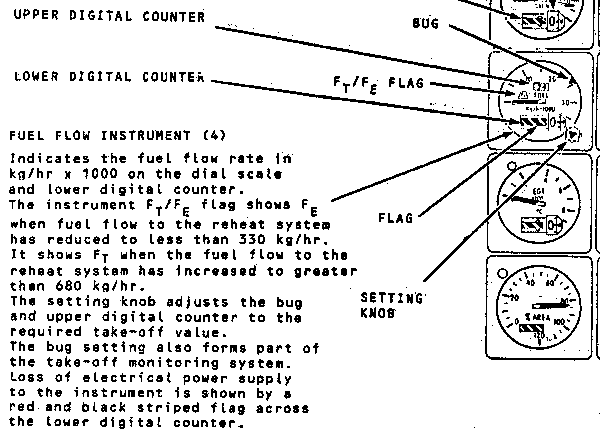
My guess is that the upper digital counter indicates the proportion of the fuel flow that goes to the reheat but it's only a guess.
Sorry, I have no figure for the max fuel consumption.
The '35 tonnes/hr' limit on the indicator is obviously beyond the upper limit, like the speedo on a car.....
But yes, fuel consumption at takeoff with reheat was horrendous, and would have emptied all the tanks in an hour or less.
CJ
Subjects
Afterburner/Re-heat
Haynes guide to Concorde
Links are to this post in the relevant subject page so that this post can be seen in context.
Reply to this quoting this original post. You need to be logged in. Not available on closed threads.
December 28, 2010, 22:01:00 GMT
permalink Post: 6147262
We're looking forward to a few more people like you telling their story.
Peronally, I still remember vaguely there's a tale of the customers of a country pub somewhere in England actually chartering a Concorde for a "round-the-bay" flight, but I've never been able to find the full story.
CJ
Subjects
Round the Bay
Links are to this post in the relevant subject page so that this post can be seen in context.
Reply to this quoting this original post. You need to be logged in. Not available on closed threads.
December 29, 2010, 23:03:00 GMT
permalink Post: 6149155
To most people, a Concorde cockpit is just a bewildering array of 'clocks' and other bits.
People like Bellerophon and Exwok read it all in seconds.
Even an ancient like me, seeing a cockpit photo, instantly recognises a museum photo, because of the toppled emergency horizon, or because of the odd bits and pieces we used on the autopilot controller on G-AXDN (01).
Unless you also include Jacqueline Auriol, probably the world's first female test pilot, who flew Concorde 001 in the earliest days.
Speaking for myself, no, it's not a void, it's a highlight, that I now like passing on, in the hope other generations will find inspiration in the 'Concorde Story' for their own endeavours.
Christian
Subjects
Auto-pilot
G-AXDN
Links are to this post in the relevant subject page so that this post can be seen in context.
Reply to this quoting this original post. You need to be logged in. Not available on closed threads.
December 31, 2010, 19:18:00 GMT
permalink Post: 6152414
She was the first French woman test pilot, and maybe also the first woman with a formal FAA(?) test pilot license.
She did fly a few 'hairy' aircraft.
But indeed nothing like Hanna Reitsch flying the V1 "Reichenberg", or the Me-163, or a very early Focke-Wulf helicopter before the war!
CJ
Subjects
V1
Links are to this post in the relevant subject page so that this post can be seen in context.
Reply to this quoting this original post. You need to be logged in. Not available on closed threads.
January 01, 2011, 18:19:00 GMT
permalink Post: 6153722
I've never seen that mentioned.... would be really interesting to know if it actually happened.
Of course everybody knows about Phil Collins "being in two places at once" thanks to Concorde, but with the right timing an overflight of Wembley sounds quite possible.
CJ
Subjects: None
No recorded likes for this post (could be before pprune supported 'likes').Reply to this quoting this original post. You need to be logged in. Not available on closed threads.
January 01, 2011, 20:51:00 GMT
permalink Post: 6153915
Paul Goes, Luxembourg
CJ
PS I was just reading all the other comments from that BBC link.... Sad.
Subjects
JFK
Links are to this post in the relevant subject page so that this post can be seen in context.
Reply to this quoting this original post. You need to be logged in. Not available on closed threads.
January 01, 2011, 23:20:00 GMT
permalink Post: 6154135
Concorde During Eclipse | Surfer Jerry
The first one was the 1973 chase over Africa by Concorde 001, which lasted 74 minutes in all.
The other one was the one in 1999, when three Concordes did a brief chase, but without any special equipment on board.
BTW, the picture from "Surfer Jerry" is a very nice and impressive PhotoShop creation... but it's not real. There was no other aircraft accompanying 001 during that flight....
 ) - are there any photographs of the windows installed for this event?
) - are there any photographs of the windows installed for this event?
Chasing The Sun: A Supersonic Celestial Observation | Scienceray
It sounds a completely magical experience!!
IIRC there were three windows installed in the roof.
I've seen photos of the installation, but I'm not sure if any of them are on the internet.
If you're really interested I can ask the Mus\xe9e de l'Air.
The windows were removed after the flight and the openings blanked off, but if you know where to look you can still see them.
For those who read French, there's a great description of the flight in Andr\xe9 Turcat's book "Essais et Batailles".
And because he was flying the plane.... he himself never saw the eclipse as such.
CJ
Subjects: None
No recorded likes for this post (could be before pprune supported 'likes').Reply to this quoting this original post. You need to be logged in. Not available on closed threads.
January 02, 2011, 15:11:00 GMT
permalink Post: 6155142
Looking through my 'archive', I've finally found this photo again... been looking for it for ages.
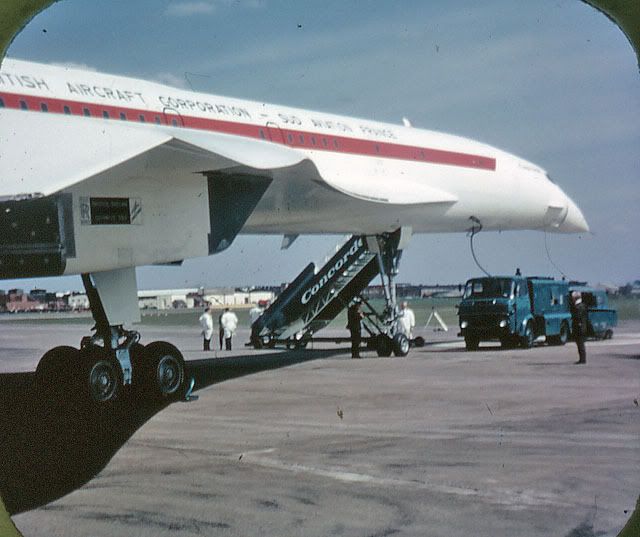
Kinky .... !!
Found on the net a few years ago. It's either 002 (G-BSST) or 01 (G-AXDN) at Fairford.
All Concordes have this 'kink', but the interesting thing is, that it's only visible from one very precise spot in line with with the wing leading edge. A few metres to the left or right, or forward or back, and the 'kink' disappears.
Many people are not even aware it exists.
Happy 2011 to all !
CJ
Subjects
Fairford
G-AXDN
Links are to this post in the relevant subject page so that this post can be seen in context.
Reply to this quoting this original post. You need to be logged in. Not available on closed threads.
January 02, 2011, 21:17:00 GMT
permalink Post: 6155651
It's always fun doing a bit of 'aero-archaeology'.... isn't it?
You're both right.
At the roll-out, 01 was already marked "AEROSPATIALE", and the tracking camera 'target' was already painted on the right-hand side (but not on the left!).
So the earlier photo in question is definitely 002.
I recently re-scanned my ancient 'Filton' photos... only black-and-white, but maybe worth adding them to the 'records'.
G-AXDN being moved out of the hangar.
Interestingly, no tracking camera target on the left-hand side.... it must have been added very soon after, because I have a photo from a few weeks later, where it's in place on both sides.
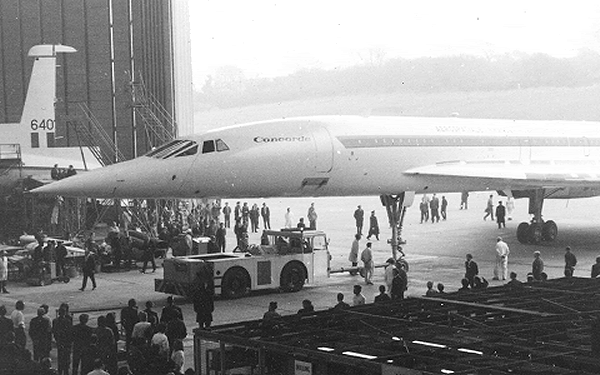
Roll-out or not, G-AXDN still wasn't quite finished... three of the four engine nozzles/thrust reversers are still missing and replaced provisionally by 'space frames'.
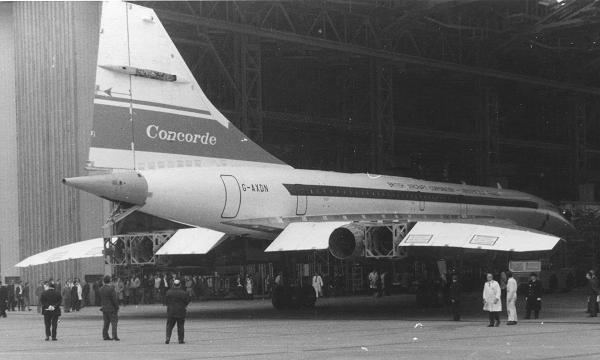
This one again confirms the "AEROSPATIALE" marking. Also, somebody hadn't gotten round to painting the tail cone yet....
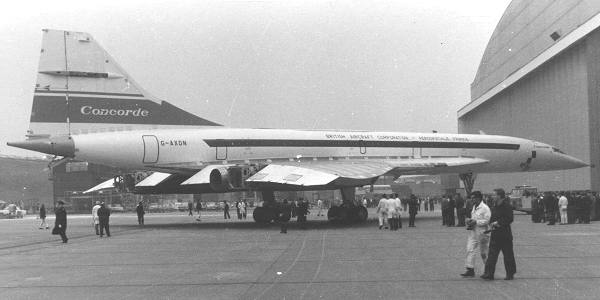
CJ
Oh, and a PS....
Another 'kinky' photo, this one of 001 when still outside the Le Bourget museum.

(Photo from the ConcordeSST.com site).
Subjects
Filton
G-AXDN
Le Bourget
Links are to this post in the relevant subject page so that this post can be seen in context.
Reply to this quoting this original post. You need to be logged in. Not available on closed threads.

 I believe she even test flew a V1 (Doodlebug)!!
I believe she even test flew a V1 (Doodlebug)!!